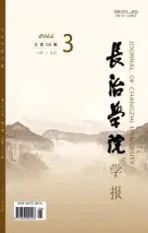汉译英中“冗余对子”的鉴别与纠正
2011-08-15毛红梅钟为晓
毛红梅,钟为晓
(1.天水师范学院 外国语学院,甘肃 天水 741001;2.兰州城市学院 外国语学院,730070)
汉译英中“冗余对子”的鉴别与纠正
毛红梅1,钟为晓2
(1.天水师范学院 外国语学院,甘肃 天水 741001;2.兰州城市学院 外国语学院,730070)
翻译是一种跨语言交际,译者在翻译过程中不可避免地要处理源语言中的冗余信息,处理不当会造成不符合英语习惯的中式英语。“冗余对子”是中式英语的主要表现之一。文章通过实例探讨汉译英中冗余对子的鉴别与纠正,以期对翻译教学有所启示。
汉译英;冗余对子;表现形式
一、引言
“冗余(Redundancy)”这一概念最初由信息论创始人申农在信息科学的研究中提出来,随后被借用到统计、语言、文字等领域。冗余现象在语言中是普遍存在的。Richards等人(2000:389)认为:冗余是指为了保证理解,信息包含多于所需的内容。语言有一种固有的冗余度,即一句话总包含着多于理解所需的内容。王寅(1993:267)认为:冗余是指超过传递信息所需最小量的现象。为了保证理解,交际时一般总是用比有效信息多得多的信息。西方现代交际理论认为:交际过程中,信息接受者得到的信息与信息发出者发送的信息可能会产生不等值的现象。信息发出者为了确保信息的正确传递,采取了一些补偿手段,如重复、拉长或重叠等,以弥补信息上的不等值,从而达到交际的成功,这些补偿手段就构成了语言交际过程中的冗余信息(赵刚,2004)。
翻译是一种跨语言交际,译者在翻译过程中不可避免地要处理源语言中的冗余信息。汉语由于修辞上的需要、结构上的平衡和语法完整的需要等因素,所蕴含的冗余信息在词汇、句子、段落、篇章之中都有体现。而英语是一种理性的语言,在本质上最忌文字堆砌,讲究的是言简意赅。Strunk和White(1979)认为:“Vigorous writing is concise.A sentence should contain no unnecessary words,a paragraph no unnecessary sentences.”但稍加注意就会发现,在包括杂志、新闻、广告、政府报告,甚至食品说明等各种汉译英文本中都包含不必要的词,而学生汉译英练习、作文中这种现象更为普遍。“冗余对子”(redundant twins)是中式英语的主要表现之一。本文通过实例探讨汉译英中冗余对子的鉴别与纠正,以期对翻译教学有所启示。
二、汉译英中冗余对子的鉴别
在汉译英过程中,经常可以看到译者用两个意义极为相近甚至相同的词,即冗余对子,如:views and opinions,prudent and cautious,sentiments and feelings,fair and equitable,ceaselessly and unremittingly等,实际上用其中一个词就足够表达原文含义。这种重复在汉语中是可接受的,有时为了避免含糊、加强语气、保持平衡与对称或语言的优美也是必要的。但在英译时逐词对应翻译会造成不必要的重复,导致不合英语语法或表达习惯的中式英语。所以作为译者,首先要确定在译文中是否有必要用两个词。
由于历史原因以及外来词的影响,英语词汇量相当丰富。而其中许多词汇都是近义,甚至是完全同义的。如 friendship/amity,wonderful/marvelous,handbook/manual,motherly/maternal,underwater/submarine,foretell/predict,wrong/erroneous,before/prior to等,这些词虽然在意义上相同,但在不同语境的具体运用上仍有差别。如“erroneous”不像“wrong”带有道德谴责意味,用法上也有区别。所以,对于一个译者,在用词时,问题不在于这两个词是否有区别,而在于在某一特殊语境中,这两个词的区别是否重要?第二个词是否对第一个词有所补充?第二个词是否表达出汉语原文中一个词不能完全表达的含义?如果答案是否定的,就可判断其为冗余对子,必须加以纠正。
三、汉译英中冗余对子的表现形式及其纠正
英语译文中冗余对子的表现形式各不相同,归纳起来有以下三类最为常见。
第一类:冗余对子中的两个词意义相同。
例1:Thisis the only road leading toaffluence and prosperity(繁荣富强).(去掉affluence)
例2:Although the road before us is rough and bumpy(崎岖不平),we believe that the favorable situation will continue.(去掉bumpy)
例3:Our store also accepts orders for blouses,shirts,pajamas…etc.,the sewing work being fine and excellent(做工精细).(改为Our store also accepts orders for blouses,shirts,pajamas…etc.all of which are finely sewn.)
这类词义相同的冗余对子,如skills and abilities,setbacks and defeats,troubles and problems,steps and measures,complaints and dissatisfactions,restrictions and shackles,consider and study,endorse and support,introduce and put into effect,triumph and overcome,defeat and overthrow,strong and solid,upright and honest,irresolute and hesitant,short and brief,correctly and properly等,在译文中也极为常见。
第二类:冗余对子中的一个词的含义包含在另一个词义当中。
例1:The present boom of foreign investment in China has prompted the country to consider and eventually work out(考虑和寻求)ways to use such investment more efficiently.(去掉consider)
例2:The Chinese Foreign Ministry spokesman called the decision“yet another attempt by British Hong Kang authorities to interfere with and undermine(干预和阻挠)the Sino-British talks.”(去掉interfere with)
第三类:冗余对子中的一个词的词义含糊,无法与另一个词区分。
例1:We should strengthen and improve(加强和改进)the system under which governments at all levels are responsible for attaining given objectives for birth control.(去掉improve)
例2:Effective guidance by the government is especially important for a healthy and rational(健康和良性)development of this industry in a socialist market economy.(healthy含义模糊,对rational没有补充作用,且可有多种解释。effective也是多余的词。可改为Governmental guidance is especially important for the rational development of this industry in a socialist market economy.)
译文中冗余对子的纠正最简单的方法是去掉其中一个词,如“geographical surveys and explorations(地质勘探)”可简化为“geographical surveys”,“attentive and meticulous(专心细致)in their work”可简化为“meticulous in their work”。
在两个词的表达都不太清楚确切的情况下,可以用另外一个词将两个词都替换掉。如“faraway,distant(偏远)areas”可用“remote”来替换。
在以上两种办法都无法表达汉语原文意义的情况下,译者可以根据具体语境和英语表达习惯增加一两个词,如“conditions and environment”可改为“working conditions and social environment”。需要注意的是,英语译文补充后可能会包含汉语原文中本来没有的意思,此时,译者一定要准确理解汉语原文,斟酌用词。
四、结语
Bussmann(2000)认为冗余信息有时不可避免。由于诸如噪音、个人言语方式、误解等因素的影响,使语言成为带有大量冗余信息的交际手段。这一点充分体现在语言描写的各个层面,尤其是形态标志和词汇重复。有时为了修辞,有意使用冗余的情况也存在,如:Each and every one was there.因此,无论是从事汉英翻译的人士还是英语教师,都应认识到,虽然在汉译英中冗余对子大量存在,但并不意味着所有的冗余对子都不可接受,因为汉英两种语言毕竟存在很大差异,都存在一定程度的不可译性。而英语中也存在冗余对子,有些是可接受的。如:rules and regulations,trials and tribulations,first and foremost, winking and blinking, huffing and puffing等,在幽默文体中可接受;再如:bits and pieces,by leaps and bounds,lo and behold,right and proper,various and sundry,the strait and narrow(path),the one and only,really and truly等,在特殊语境下可使用。所以,在英汉翻译教学中,教师要通过两种语言的对比引导学生善于分析两种语言的差异,强化词汇搭配意识,注意两种语言不同的表达习惯。在避免中式英语表达的同时,尽可能忠实于原文,斟酌用词。因为对于译者,正如Adler Sol(1978) 所说:“Meaning must have priority over ele gance”,意义永远是第一位的。
[1]Adler,Sol.1978.A Talk to Comrades of the English Section for the Translation of Volume V of Chairman Mao's Selected Works(《关于〈毛选〉第五卷翻译问题的报告》)[M].Beijing:Foreign Languages Press.
[2]Bussmann,H.2000.Routledge Dictionary of Language and Linguistics.Beijing:Foreign Language Teaching and Research Press.
[3]Richards, J.C., Platt, J.&Platt, H.2000.Longman Dictionary of Language Teaching and Applied Linguistics.Beijing:Foreign Language Teaching and Research Press.
[4]Strunk,William,Jr.&White,E.B.1979.The Elements of Style(3rd ed).New York:Macmillan.
[5]王寅.简明语义学辞典[M].济南:山东人民出版社,1993.
[6]赵刚.汉语中的冗余信息及其翻译[J].国外外语教学,2004,(4):55-57.
Redundant Twins in Chinese Translation of English
MAO Hong-mei1,ZHONG Wei-xiao2
(1.School of Foreign Languages Tianshui Normal University,Tianshui Gansu 741001 2.School of Foreign Languages Lanzhou City University,Lanzhou Gansu 730070)
Translation is a cross-linguistic communication,in the process of which the translator is expected to deal with redundant information in the target language.Inappropriate Chinese translation may lead to non-idiomatic English expressions,known as Chinese English.Redundant twins are typical of Chinese English.The present paper attempts to discuss ways of discriminating and correcting unnecessary redundant twins in teaching translation.
Chinese translation of English;redundant twins;expressive form
H315.9
A
1673-2014(2011)03-0074-03
2011—01—11
天水师范学院中青年教师科研资助项目成果(TSA0945)。
毛红梅(1966—),女,山西武乡人,讲师,硕士,主要从事应用语言学及英语教学研究。
(责任编辑 晋 红)
